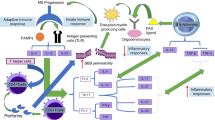Abstract
Chronic relapsing experimental allergic encephalomyelitis (CREAE) is an autoimmune model of multiple sclerosis1. Although both these diseases are typified by relapsing-remitting paralytic episodes, after CREAE induction by sensitization to myelin antigens1 Biozzi ABH mice also develop spasticity and tremor. These symptoms also occur during multiple sclerosis and are difficult to control. This has prompted some patients to find alternative medicines, and to perceive benefit from cannabis use2. Although this benefit has been backed up by small clinical studies, mainly with non-quantifiable outcomes3,4,5,6,7, the value of cannabis use in multiple sclerosis remains anecdotal. Here we show that cannabinoid (CB) receptor agonism using R(+)-WIN 55,212, Δ9-tetrahydrocannabinol, methanandamide and JWH-133 (ref. 8) quantitatively ameliorated both tremor and spasticity in diseased mice. The exacerbation of these signs after antagonism of the CB1 and CB2 receptors, notably the CB1 receptor, using SR141716A and SR144528 (ref. 8) indicate that the endogenous cannabinoid system may be tonically active in the control of tremor and spasticity. This provides a rationale for patients' indications of the therapeutic potential of cannabis in the control of the symptoms of multiple sclerosis2, and provides a means of evaluating more selective cannabinoids in the future.




Similar content being viewed by others
References
Baker, D. et al. Induction of chronic relapsing experimental allergic encephalomyelitis in Biozzi mice. J. Neuroimmunol. 28, 261 –270 (1990).
Consroe, P., Musty, R., Rein, J., Tillery, W. & Pertwee, R. The perceived effects of smoked cannabis on patients with multiple sclerosis. Eur. Neurol. 38, 44–48 (1997).
Consroe, P. Cannabinoid systems as targets for the therapy of neurological disorders. Neurobiol. Dis. 5, 534– 551 (1998).
Petro, D. J. & Ellenberger, C. Treatment of human spasticity with Δ9-tetrahydrocannabinol. J. Clin. Pharmacol. 21 (suppl.), 413–416 ( 1981).
Clifford, D. B. Tetrahydrocannabinol for tremor in multiple sclerosis. Ann. Neurol. 13, 669–671 ( 1983).
Ungerleider, J. T., Andyrsiak, T., Fairbanks, L., Ellison, G. W. & Myers, L. W. Δ9-THC in the treatment of spasticity associated with multiple sclerosis. Adv. Alcohol Substance Abuse 7, 39– 50 (1987).
Martyn, C. N., Illis, L. S. & Thom, J. Nabilone in the treatment of multiple sclerosis. Lancet 345, 579 (1995).
Pertwee, R. G. Pharmacology of cannabinoid receptor ligands. Curr. Med. Chem. 6, 635–664 ( 1999).
Lyman, W. D., Sonett, J. R., Brosnan, C. F., Elkin, R. & Bornstein, M. B. Δ9-tetrahydrocannabinol: a novel treatment for experimental autoimmune encephalomyelitis. J. Neuroimmunol. 23, 73–81 (1989).
Wirguin, I. et al. Suppression of experimental autoimmune encephalomyelitis by cannabinoids. Immunopharmacology 28, 209 –214 (1994).
Heller, A. H. & Hallet, M. Electrophysiological studies with the spastic mutant mouse. Brain Res. 234, 299–308 (1982).
Chai, C. K. Hereditary spasticity in mice. J. Heredity 52, 241–243 (1961).
Pertwee, R. G. Pharmacology of cannabinoid CB1 and CB2 receptors. Pharmacol. Therapeut. 74, 129–180 ( 1997).
Breivogel, C. S. & Childers, S. R. The functional neuroanatomy of brain cannabinoid receptors. Neurobiol. Dis. 5, 417–431 (1998).
Landsman, R. S., Burkey, T. H., Consroe, P., Roeske, W. R. & Yamamura, H. I. SR141716A is an inverse agonist at the human cannabinoid CB1 receptor. Eur. J. Pharmacol. 334, R1–R2 (1997).
Portier, M. et al. SR144528, an antagonist for the peripheral cannabinoid receptor that behaves as an inverse agonist. J. Pharmacol Exp. Ther. 288, 582–589 (1999).
Calignano, A., La Rana, G., Giuffrida, A. & Piomelli, D. Control of pain initiation by endogenous cannabinoids. Nature 394, 277–281 (1998).
Giuffrida, A. et al. Dopamine activation of endogenous cannabinoid signalling in dorsal striatum. Nature Neurosci. 2, 358 –363 (1999).
Huffman, J. W. et al. 3-(1′,1′-Dimethylbutyl)-1-deoxy-Δ9-THC and related compounds: synthesis of selective ligands for the CB2 receptor. Bioorg. Med. Chem. 7, 2905–2914 (1999).
Noth, J. Trends in the pathophysiology and pharmacotherapy of spasticity. J. Neurol. 238, 131–139 (1991).
Acknowledgements
The authors would like to thank the Multiple Sclerosis Society of Great Britain and Northern Ireland, the Medical Research Council, the National Institute on Drug Abuse and the Wellcome Trust for their financial support.
Author information
Authors and Affiliations
Corresponding author
Rights and permissions
About this article
Cite this article
Baker, D., Pryce, G., Croxford, J. et al. Cannabinoids control spasticity and tremor in a multiple sclerosis model . Nature 404, 84–87 (2000). https://doi.org/10.1038/35003583
Received:
Accepted:
Issue Date:
DOI: https://doi.org/10.1038/35003583
- Springer Nature Limited
This article is cited by
-
Spinal astroglial cannabinoid receptors control pathological tremor
Nature Neuroscience (2021)
-
Cannabinoids and the expanded endocannabinoid system in neurological disorders
Nature Reviews Neurology (2020)
-
Paternal activation of CB2 cannabinoid receptor impairs placental and embryonic growth via an epigenetic mechanism
Scientific Reports (2019)
-
Chemical fingerprinting of single glandular trichomes of Cannabis sativa by Coherent anti-Stokes Raman scattering (CARS) microscopy
BMC Plant Biology (2018)
-
New approaches and challenges to targeting the endocannabinoid system
Nature Reviews Drug Discovery (2018)





